
Welcome to our cultural journey, where today, we set our course to the heart of the Land of the Morning Calm – South Korea. Known for its pulsating K-Pop beats and tantalizing culinary delights like the famed Korean barbecue, Korea’s influence permeates global culture. However, there is an immensely rich and enchanting side to Korean culture that is often unseen and unexplored – its traditional wedding customs. So whether you’re a Korean drama aficionado, a lover of Korean cuisine, or perhaps even planning a Korean-style wedding, join us as we delve into the captivating and symbol-laden world of Korean wedding traditions, a beautiful blend of ancient rituals and contemporary trends.
What exactly makes Korean nuptials so interesting? For starters, they’re full of symbolism, ancient rites, and gift-giving. Additionally, they’re not just about joining two people together. Instead, the ceremony represents a union between two entire families.
Keep reading to learn more about Korean pre-wedding traditions, typical attire, and what’s on the menu. Plus, we’ll give you a step-by-step walkthrough of what to expect if you’re ever invited to a Korean wedding ceremony.
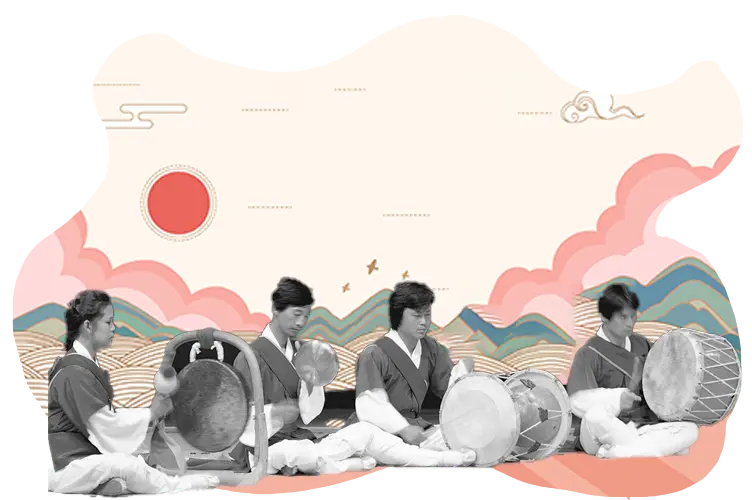
Korean weddings are relatively quick affairs, lasting only a couple of hours at most. However, pre-wedding traditions add a festive feel to the event. One, samulnori, is performed right before the wedding ceremony. The other, hahm, can happen anytime before the wedding day.
Translated literally, “samulnori” means “playing four objects.” As you might expect, this performance features four instruments: kkwaenggwari (a small gong), jing (a larger gong), janggu (an hour-glass shaped drum), and buk (barrel drum). The performance also includes a traditional fan dance called a buchaechum.
Besides the samulnori performance, the giving of betrothal gifts (hahm) is another beloved Korean pre-wedding tradition. It requires the groom’s friends to bring a box of jewels and other gifts to the bride’s house. The bride’s family barters and offers money for the gifts until they’ve purchased them all.
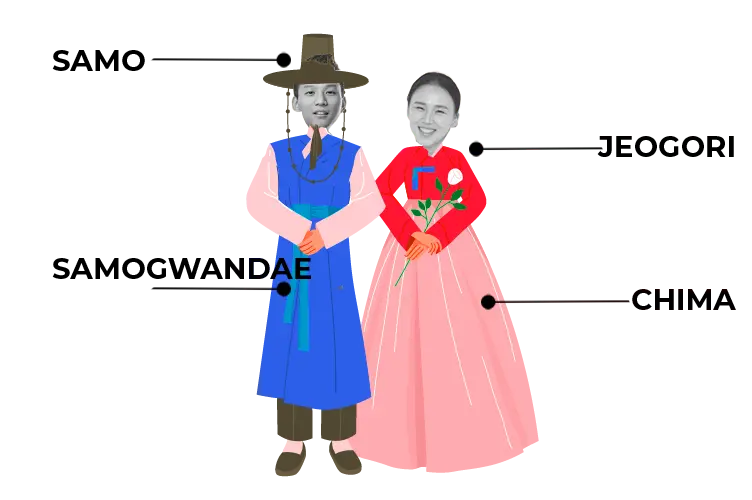
Many Korean brides choose to wear hanbok, also known as traditional clothing. Hanbok consists of a long-sleeved top (jeogori) and a skirt (chima). For more formal weddings, the bride might trade the jeogori for a wonsam, a topcoat embroidered with silk thread.
Groom wear also includes a hanbok. The more formal version of this clothing is called samogwandae. Samogwandae consists of a robe-like topcoat layered over pants and a jacket. The finishing touch is a black cap with wings on each side (samo). Less formal grooms wear loose-fitting pants called baji; durumaji, a top coat; and either a hat (gat) or a headpiece (iksunkan).
Although traditional clothing is widely accepted, modern Korean weddings may feature Western-style clothing, including a white dress for the bride and a suit for the groom. That said, couples usually wear these garments for the ceremony only, then change into hanbok for the reception.
Koreans celebrate their culture not only through their clothing, but also through the colors they wear. Traditional wedding colors represent taeguk, or yin and yang, which symbolizes the balance of energy needed for a healthy life. The bride wears red hanbok, while the groom wears blue. Put together, the enthusiasm and energy of the red (yang) balances the healing and relaxing vibes of the blue (yin).
The bride’s mother and groom’s mother also both wear symbolically-colored clothing. Like her daughter, the mother of the bride wears warm colors such as pink, purple, or orange. The groom’s mother wears cool tones like blue, gray, or light green.
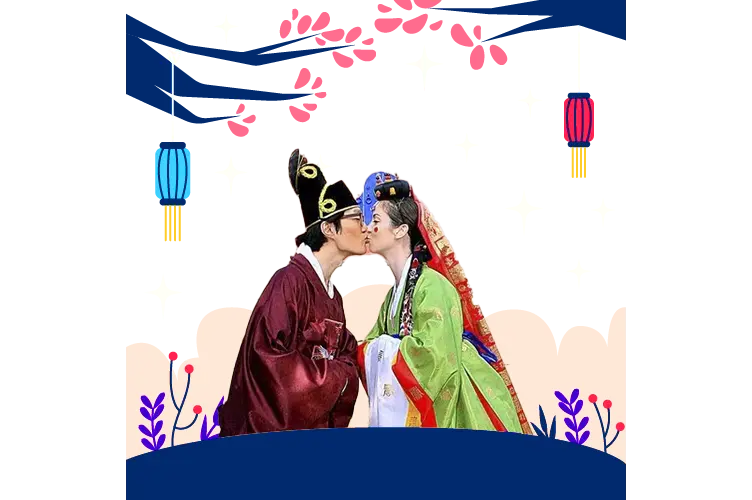
Weddings are a big business in Korea, and banquet halls dedicated to hosting them churn out several weddings a day. As you can imagine, that means Korean wedding ceremonies are over in the blink of an eye. Still, despite the rapid pace, there are plenty of rituals to look out for.
Traditional Korean weddings start with a processional parade (jum-chok rye). As traditional music plays, the officiant enters. Next, the bride and groom’s mothers enter together. Each holds a candle — red for the bride’s mother and blue for the groom’s mother. As with the traditional clothing, these colors represent the balance between yin and yang. When the mothers reach the end of the aisle, they light a single candle together.
Next, the groom enters carrying a goose. In the past, the groom would hold a wild goose, but nowadays, it’s usually a wooden replica. The groom gifts the goose to his mother-in-law in a ritual called jeonanyrye. Geese mate for life, making them a striking symbol of the lifelong commitment the groom promises to his new wife.
After jeonanyrye, the bride walks in. She and the groom stand opposite one another at a table containing a copper bowl. With the help of their attendants (aka, the wedding party), they wash their hands. Called gyobaerye, this practice symbolizes the purity each partner brings to the relationship.
Following the handwashing, the bride and groom bow to one another before kneeling to face one another.
The final part of most ceremonies is hapgeunrye, when the couple drinks a special wine called jung jong from the same copper cup. The first sip represents their relationship, while the second sip represents an interchange. They finish by bowing to show respect to their parents, ancestors, and wedding guests.
Representing family, paebaek is one of the most important parts of a traditional Korean wedding ceremony. In the past, it was a private event between the groom’s parents and the couple. It took place at the end of the wedding ceremony. These days, both sets of parents are invited and paebaek now takes place publicly, during the wedding reception, so everyone can enjoy this lighthearted ceremony.
Paebaek begins with the parents sitting behind a low table covered with food. The couple approaches, bows, and pours tea before receiving gifts and blessings. Next they sit and hold a white cloth between them, using it to catch dates and chestnuts that their parents throw. The dates represent the number of sons the couple will have, and the chestnuts the number of girls.
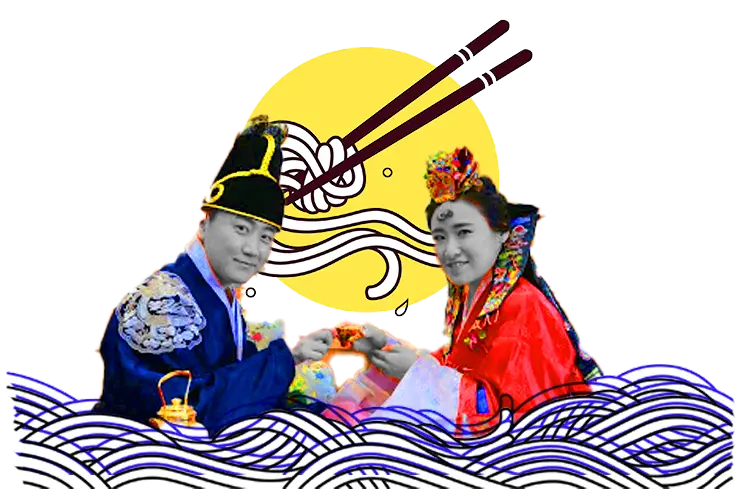
From bibimbap to bulgogi, Korean cuisine has gained quite a reputation around the world. In comparison, however, Korean wedding food is simple.
Noodle soup is the only required dish, as it symbolizes a long and happy life for the couple. On top of soup, many Korean weddings feature rice, dumplings, and deep-fried vegetables (twigim). Dok, or sticky rice cakes, are the most common dessert.
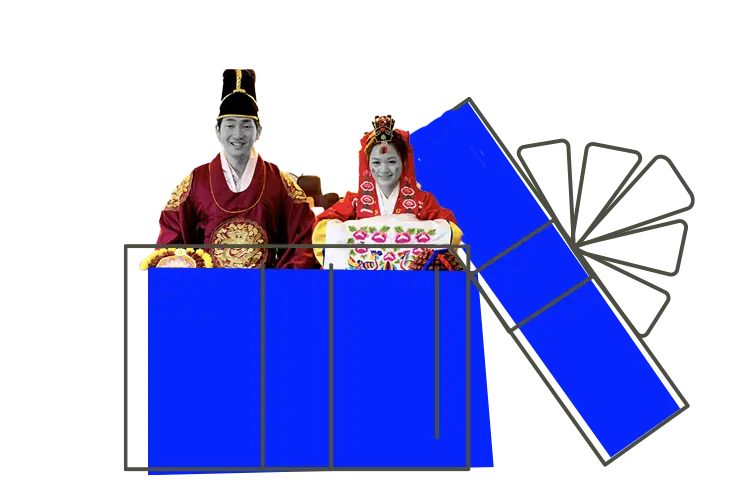
Forget the serving bowls and guest towels. Korean wedding gifts are all about the cash.
Called chug ui-geum, this celebratory money is given in a white envelope. Unlike cash gifts at American weddings, though, chug ui-geum isn’t so much a suggestion as it is a requirement in order for guests to eat at the reception. Guests literally swap their money for a meal ticket upon arrival.
Guests give money in odd amounts between $30 and $200. The amount depends on the giver’s relationship to the couple.
Korean tradition dictates that the groom’s family cover wedding expenses. This includes the cost of the venue, catering, and any other expenses. The bride’s family usually pays for her wedding dress. That said, some families split the cost. In other cases, the couple pays for their own wedding.
Weddings in Korea are fairly conservative family affairs. As a result, a kiss is not part of traditional ceremonies. The closest thing you’ll see to PDA are couples holding hands. Korean couples also do not exchange vows or rings.
No color is off-limits at Korean weddings. Still, guests are encouraged to wear more subdued colors (like pastels or neutrals) to ensure attention stays on the newlyweds.
Many older Korean couples do not wear wedding rings. Younger Koreans have adopted this Western tradition, wearing both engagement and wedding rings.
Whether you’re just learning about Korean culture or are a full-fledged Koreaphile, we hope you’ve discovered all kinds of interesting, new facts about Korean weddings. Maybe you’ll incorporate some of these traditions into your own wedding ceremony!
Want to learn more about potential wedding traditions to incorporate into your wedding? Check out our article on need-to-know wedding traditions for grooms. Or if you need any dance tips, we’ve got your back! Check out all the latest articles for more tips and info we have to offer!